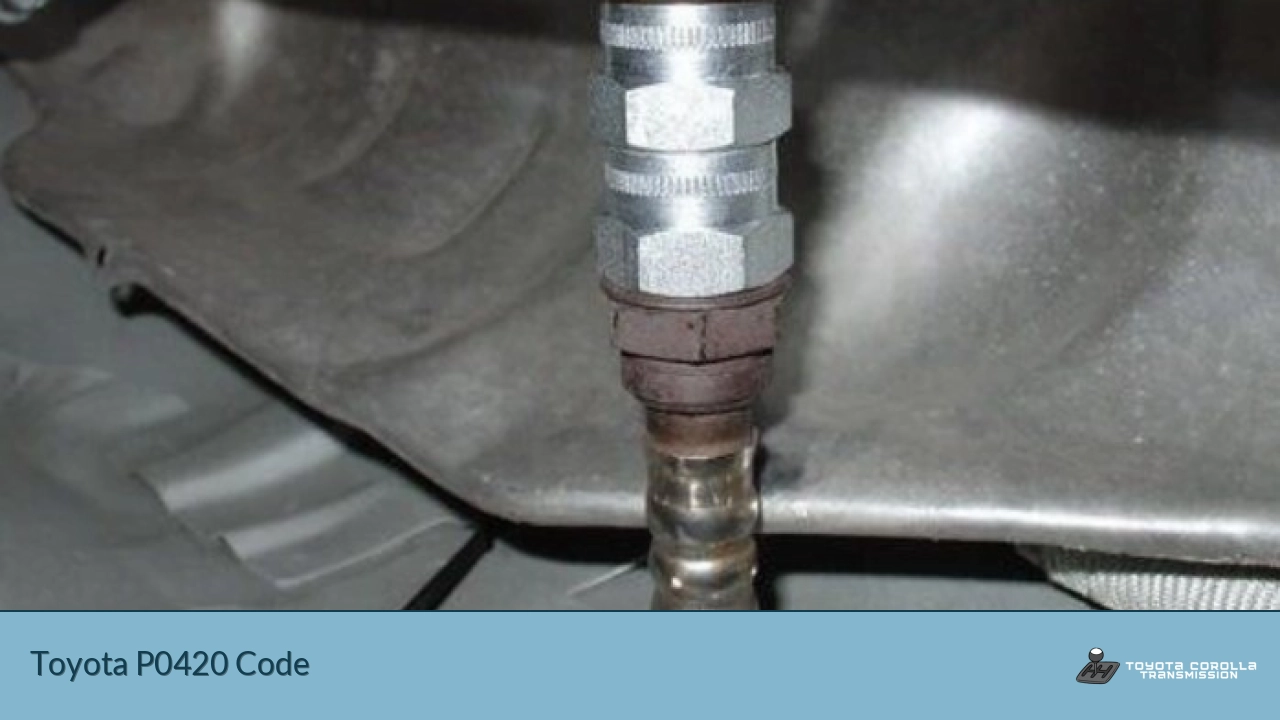The P0420 code is a common issue that plagues many Toyota owners, often leaving them scratching their heads in confusion. This diagnostic trouble code (DTC) indicates a problem with the catalytic converter system’s efficiency in bank 1 of the engine. While it may sound complex, understanding this code is crucial for maintaining your Toyota’s performance and passing emissions tests.
| Component | Possible Causes | Symptoms |
|---|---|---|
| Catalytic Converter | Faulty performance, low efficiency | Check engine light, rotten egg smell, decreased performance |
| Oxygen Sensor | Malfunctioning, affecting readings | Erratic fuel readings, idle issues, check engine light |
| Wiring | Damage or corrosion impacting signals | Inconsistent performance, electrical shorts, dashboard alerts |
Understanding the P0420 Code
The P0420 code specifically refers to the catalytic converter system’s efficiency falling below the threshold in bank 1 of the engine. This means that the catalytic converter is not effectively reducing harmful emissions as it should. The vehicle’s onboard computer detects this issue through the oxygen sensors placed before and after the catalytic converter.
The Role of the Catalytic Converter
The catalytic converter is a critical component of your Toyota’s exhaust system. Its primary function is to convert harmful pollutants in the exhaust gases into less harmful emissions before they exit the tailpipe. When functioning correctly, it helps your vehicle meet stringent emissions standards and contributes to a cleaner environment.
How the System Works
Your Toyota’s engine control module (ECM) constantly monitors the efficiency of the catalytic converter by comparing the readings from two oxygen sensors:
- The upstream sensor (before the catalytic converter)
- The downstream sensor (after the catalytic converter)
When the catalytic converter is working correctly, there should be a significant difference between these two readings. If the ECM detects that the readings are too similar, it triggers the P0420 code.
Common Causes of the P0420 Code
Several factors can lead to the P0420 code appearing in your Toyota:
Failing Catalytic Converter
The most common cause is a failing catalytic converter. Over time, the catalyst material inside the converter can become contaminated or damaged, reducing its efficiency. This often occurs due to age, high mileage, or exposure to contaminants in the exhaust stream.
Oxygen Sensor Issues
Faulty oxygen sensors can provide incorrect readings to the ECM, leading to a false P0420 code. These sensors can degrade over time or become contaminated, affecting their accuracy.
Exhaust Leaks
Leaks in the exhaust system, particularly between the engine and the catalytic converter, can allow additional oxygen into the system. This can skew the oxygen sensor readings and trigger the P0420 code.
Engine Performance Problems
Issues such as misfires, rich fuel mixture, or oil consumption can lead to excessive contaminants entering the catalytic converter, reducing its efficiency and potentially triggering the P0420 code.
Diagnosing the P0420 Code
Proper diagnosis is crucial to avoid unnecessary repairs. Here’s a step-by-step approach:
- Use an OBD-II Scanner: Connect a scanner to retrieve the code and any related freeze frame data.
- Visual Inspection: Check for visible damage to the exhaust system, including the catalytic converter and oxygen sensors.
- Monitor Oxygen Sensor Data: Use a scan tool to observe the upstream and downstream oxygen sensor readings. A properly functioning system should show fluctuating upstream readings and steady downstream readings.
- Check for Exhaust Leaks: Perform a thorough inspection of the exhaust system for any leaks or damage.
- Assess Engine Performance: Look for other issues that could be affecting the catalytic converter’s efficiency, such as misfires or excessive oil consumption.
Resolving the P0420 Code
Once you’ve identified the root cause, you can take steps to resolve the issue:
Catalytic Converter Replacement
If the catalytic converter is indeed faulty, replacement is often the most effective solution. While this can be expensive, it’s crucial for maintaining your Toyota’s performance and meeting emissions standards.
Oxygen Sensor Replacement
If diagnostic tests indicate faulty oxygen sensors, replacing them can often resolve the P0420 code. Always use high-quality, OEM-equivalent sensors for the best results.
Exhaust System Repair
Address any leaks or damage in the exhaust system. This may involve replacing gaskets, tightening connections, or repairing damaged pipes.
Engine Performance Tune-up
Addressing underlying engine issues can prevent future catalytic converter problems. This might include replacing spark plugs, adjusting fuel trims, or fixing oil consumption issues.
Preventing Future P0420 Codes
To avoid encountering the P0420 code in the future:
- Follow your Toyota’s recommended maintenance schedule
- Use high-quality fuel and oil
- Address check engine lights promptly
- Avoid short trips that don’t allow the engine to reach full operating temperature
FAQs
What does the P0420 code mean for my Toyota?
It indicates that your catalytic converter system’s efficiency is below the required threshold, potentially due to a failing converter or related components.
Can I drive with a P0420 code?
While you can drive short distances, it’s not recommended for extended periods as it may cause further damage and increased emissions.
How much does it cost to fix a P0420 code?
Costs vary widely, from $100 for a simple oxygen sensor replacement to $2000+ for a new catalytic converter, depending on the root cause and your Toyota model.
Will a P0420 code clear itself?
The code may clear temporarily but will likely return unless the underlying issue is addressed.
Can a bad O2 sensor cause a P0420 code?
Yes, faulty oxygen sensors can provide incorrect readings to the ECM, potentially triggering a false P0420 code.

